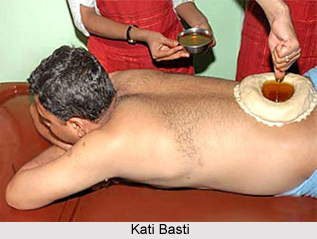 Literally, the word Kaya means body and chikitsa means treatment. But the cumulative meaning of the word kayachikitsa is the treatment of internal and external ailments in every possible way as well as the maintenance of a healthy body throughout life. Kayachikitsa targets the entire body and not just the ailing portion. This branch of treatment incorporates change in food habits , change in clothing, change in housing to suit the seasonal cycles and an overall change in lifestyle. Ayam and vyayam (exertion and exercise), yogasadhana (yogic exercises for body and mind), gati (movement) constitute a part of kayachikitsa .Thus, this branch of Ayurveda, meting out a total treatment to the body, ensures health and well-being.
Literally, the word Kaya means body and chikitsa means treatment. But the cumulative meaning of the word kayachikitsa is the treatment of internal and external ailments in every possible way as well as the maintenance of a healthy body throughout life. Kayachikitsa targets the entire body and not just the ailing portion. This branch of treatment incorporates change in food habits , change in clothing, change in housing to suit the seasonal cycles and an overall change in lifestyle. Ayam and vyayam (exertion and exercise), yogasadhana (yogic exercises for body and mind), gati (movement) constitute a part of kayachikitsa .Thus, this branch of Ayurveda, meting out a total treatment to the body, ensures health and well-being.
The Charaka Samhita is the most significant scripture on kayachikitsa. It talks about the fundamental rules of treatment, various types of remedies and cleansing or detoxifying techniques . The concept of kayachikitsa holds that the body of a person is the product of regular psychosomatic interactions. The disparity in the three doshas of vata-pitta-kapha sometimes crop up from disturbances in the mind or irregularities in the body`s dhatu (tissues) and mala (toxin deposits). Hence, the kayachikitsa branch of Ashtang Ayurveda is concerned with determining the root cause of the disease. In Ashtang Ayurveda all the remedial measures are based on the concept of Agni or fire, which is another analogy for Kaya . Kaya or Agni promotes bio-transformation in the human body and provides energy for all the required metabolic processes in the body. We all know that energy can neither be created nor destroyed but changes from one form to another, the total energy of the system remaining constant. Our body obtains energy from the food we eat and the air we breathe. The biological system transforms this energy to a form that can be utilized by the cells. Kayachikitsa treats every ailment keeping these basic principles in mind .
The segment of Nidana Sthana of Charaka Samhita deals with etiology, pathogenesis and diagnosis of an illness. According to this segment, there are six stages of the development of a disease. These are aggravation, accumulation, overflow, relocation, building up in a new spot and appearing as an identifiable ailment. Kayachikitsa leaves ample room for checking the disease at each stage of proliferation thus averting its full manifestation.The curative procedure of kayachikitsa can be divided into three parts. These are purva-karma (pre-procedures), panch-karma (five main procedures which are executed when thorough cleansing of the body is necessary) and pashchat-karma (follow-up treatment). The most significant among these methods of treatment under kayachikitsa is panch-karma. This is a process of reverting the path of the disease from the stage when it has become notriceable to the site of itsoriginal development through special forms of emesis, purgation and enema . Panch-karma includes vaman (artificially induced vomitting) , virechan (cleaning the bowel with the help of mild or herbal laxatives) , basti (medicated enema ) , nasya (application of medicines through the nasal channel ) and raktamoksha (the letting out of impure blood). Panch-karma follows purva-karma and precedes pashchat-karma. Purva-karma includes snehan (oiling of the body internally or externally) and swedan (induced sweating, preferably done after snehan). Treatments like balya or bruhan (reinforcing the body), santarpan (nurturing the body), rasayana (rejuvenating therapy) and vajikaran (improving sexual performance) come under pashchat-karma.
 Another exclusive aspect of kayachikitsa is rejuvenation or kaya kalpa. The term kaya kalpa means revitalization of the body. According to Ayurveda the human body is made of seven types of dhatu or tissue elements. They are as follows: plasma, blood, muscle, fat, bone, marrow and reproductive fluids. To retain the youthfulness of the body for a prolonged period of time kayachikitsa takes recourse to numerous physical and mental corrective procedures with the help of special medicinal preparations. These help to rebuild the body`s cells and tissues after the preliminary process of purgation, through panchakarma. Kayachikitsa deals with the diagnosis and cure of various general diseases like skin disorders, diabetes, tuberculosis, rheumatoid arthritis and the like.
Another exclusive aspect of kayachikitsa is rejuvenation or kaya kalpa. The term kaya kalpa means revitalization of the body. According to Ayurveda the human body is made of seven types of dhatu or tissue elements. They are as follows: plasma, blood, muscle, fat, bone, marrow and reproductive fluids. To retain the youthfulness of the body for a prolonged period of time kayachikitsa takes recourse to numerous physical and mental corrective procedures with the help of special medicinal preparations. These help to rebuild the body`s cells and tissues after the preliminary process of purgation, through panchakarma. Kayachikitsa deals with the diagnosis and cure of various general diseases like skin disorders, diabetes, tuberculosis, rheumatoid arthritis and the like.
Thus we see that kayachikitsa aims at total cure by purgation and purification. The body becomes ill when it cannot carry out the metabolic processes properly. All the logical and systemic procedures of kayachikitsa help in bringing the heyward dosha-dhatu-mala back to their normal condition. They also go a long way in eradicating ama (toxins) from the body.





